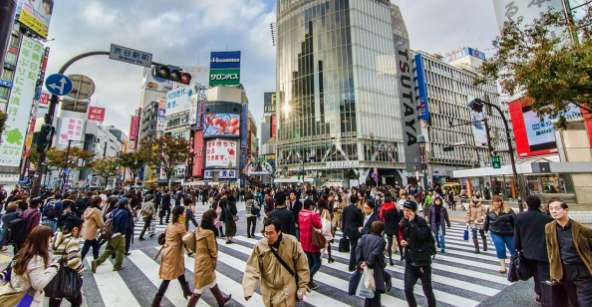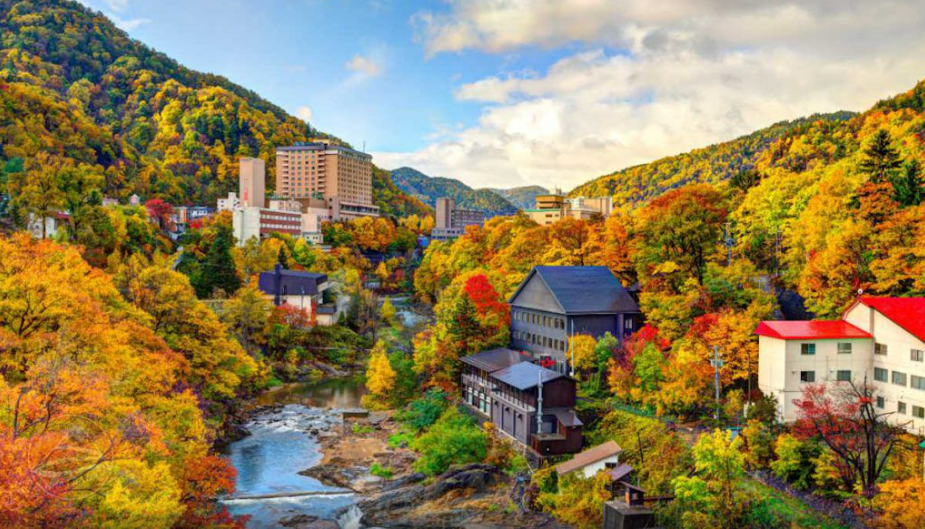Exploring Japan’s Top 5 Ancient Castles: Symbols of History and Architecture
Date: 2025.11.19
Japan’s Famous Castles: Symbols of History and Architecture 🏯
A nation rich in history and culture, Japan is renowned for its majestic and ancient castles. These impressive structures are not only symbols of power and military strategy from the feudal era but also living testaments to Japan’s sophisticated architectural techniques and craftsmanship. Each castle possesses a unique history and continues to captivate millions of visitors from around the globe 🗺️.
Below, we introduce some of Japan’s most famous castles. Each one holds its own distinct charm and historical significance:
1. Himeji Castle (Himeji-jō) – The Elegant “White Heron Castle” (Shirasagi-jō) 🕊️
Himeji Castle is affectionately known as “Shirasagi-jō” (White Heron Castle) due to its graceful, pristine white color and its unique architectural beauty, which resembles a white heron taking flight with its wings spread. Located in Himeji City, Hyogo Prefecture, this castle is one of the few original castles remaining from the feudal era and is registered as a UNESCO World Heritage Site ✨.
Himeji Castle stands out for its complex defense system, consisting of multiple walls, moats, and maze-like passageways, showcasing the peak of military technology of its time 🛡️. However, its greatest appeal lies in the intricate architectural beauty created by its curving tiled roofs and brilliant white walls. It creates a particularly breathtaking spectacle during the cherry blossom season 🌸.
🏯 Himeji Castle: History and Visitor Guide – The Charm of the “White Heron Castle” 🕊️
Himeji Castle (Himeji-jō) is a UNESCO World Heritage site that Japan proudly presents ✨.
📜 A History Beyond Time (*Rekishi o Koeta Rekishi*)
It began as a small fort in 1333.
It was dramatically expanded into its magnificent scale by Ikeda Terumasa between 1601 and 1609.
Amazingly, it has survived over 400 years without ever being destroyed by war! 💪
It was designated a National Treasure in 1931 and a UNESCO World Heritage Site in 1993.
🤔 Why is it Called “Himeji”?
The name “Himeji” is derived from Himeyama (Hime Hill), where the castle stands.
According to ancient myths, “Himeji” might be related to *himeko*, an old word for silk, as the area was once famous for silk 🦋.
Its nickname, “Shirasagi-jō” (White Heron Castle), was given because its white, elegant appearance resembles a white heron spreading its wings 🦢.
🚄 Access to Himeji (*Himeji e no Akusesu*)
Shinkansen (Bullet Train): Easy access to Himeji Station from Tokyo, Kyoto, Osaka, and Kobe.
From the Station: A 15–20 minute walk 🚶♀️, a 5-minute loop bus ride around the castle 🚌, or a taxi 🚕.
🌳 Tourist Attractions Around Himeji Castle (*Jōhen no Kankō Supotto*)
Kōko-en Garden: A breathtakingly beautiful traditional Japanese garden right next to the castle 🌸.
Shosha-zan Engyō-ji: An ancient mountain temple complex. A place of quiet, peaceful scenery 🧘♀️, also used as a filming location for the movie *The Last Samurai* 🎬.
🍜 Fascinating Local Cuisine (*Miryoku-teki na Gurume*)
Himeji Oden: A local type of *oden* served with a ginger-soy sauce dip 🥢.
Eki-soba: A unique soba dish found in the station. An interesting mix where a ramen-style broth blends with soba noodles 🍜.
Anago: Himeji’s famous grilled sea eel (similar to freshwater eel) 🐟🔥.
Gozasōrō: A locally loved, traditional *Kaiten-yaki* (Imagawa-yaki) sweet filled with delicious *anko* (red bean paste) 🍮.

Source: travel.rakuten.com
2. Osaka Castle (Ōsaka-jō) – A Symbol of Power 💪
Osaka Castle is one of the most important historical symbols for both Osaka City and Japan as a whole. Originally constructed in the 16th century by Toyotomi Hideyoshi, one of Japan’s greatest unifiers, the castle was the stage for numerous historical battles and served as the center of power for the Toyotomi clan 👑.
While the current main keep has undergone repeated destruction and reconstruction, its majesty and grandeur remain, characterized by massive stone walls, a towering *tenshu* (main keep), and an interior that showcases historical artifacts 📜. The sprawling Osaka Castle Park is the perfect place to stroll, enjoy the scenery, and learn about history 🌳.
🏯 Access Methods (*Akusesu Hōhō*) 🚉
The nearest stations are Osakajō-kōen Station or Morinomiya Station on the JR Loop Line, or Tanimachi 4-chome Station on the subway.
It is a 10–20 minute walk from each station.
🌳 Tourist Attractions Around the Castle (*Jō Shūhen no Kankō Supotto*)
Osaka Castle Park (*Ōsaka-jō Kōen*): Perfect for walking and enjoying the scenery (especially during cherry blossom and autumn foliage seasons).
Osaka Museum of History (*Ōsaka Rekishi Hakubutsukan*): Learn about history and enjoy a panoramic view of the castle.
🍜 Must-Try Osaka Cuisine (*Ōsaka no Chūmoku Gurume*)
Takoyaki(octopus balls) 🐙, Okonomiyaki(savory pancake) 🥞, Kushikatsu (deep-fried skewers) 🍢, *Udon* (thick wheat noodles) 🍜.

Source: osakacastle.org
3. Kumamoto Castle – A Masterpiece of Defensive Architecture 🧱
Kumamoto Castle, located in Kumamoto City, Kumamoto Prefecture, is known as one of Japan’s Three Great Castles (along with Himeji Castle and Matsumoto Castle). This castle is famous for its robust and elaborate defensive architecture, designed to withstand samurai attacks ⚔️.
📜 The History of Kumamoto Castle
It is one of Japan’s most impregnable fortresses, best known for the defensive designs of Katō Kiyomasa. It was completed by Katō Kiyomasa in 1607 (rebuilt and expanded over seven years from its original fort). Seinan War (1877): It was the site of a siege that lasted over 50 days. The main keep was burned down, but the Imperial forces successfully defended the castle. Reconstruction (1960): The *dai-tenshu* (large main keep) was rebuilt using reinforced concrete.
Although it suffered extensive damage in the 2016 Kumamoto Earthquakes, restoration work is currently underway to return it to its original beauty 🛠️. Kumamoto Castle remains a fascinating tourist destination where you can witness the ingenuity of its defensive design and its valiant history.
Transportation🚉
Tram (*Shiden*): Take the tram from JR Kumamoto Station to Kumamotojō-mae Station (approx. 17 minutes).
From afar: Fly to Kumamoto Airport; take the Shinkansen from Fukuoka (approx. 40 minutes).
Tourist Attractions Around the Castle🌳
Suizenji Jōjuen Garden: A traditional stroll garden
Kumamon Square: The place to meet Kumamon (mascot)
Mount Aso: (A bit further) A majestic active volcano
Must-Try Cuisine 🍜
Basashi: Fresh horse meat sashimi.
Kumamoto Rāmen: A distinctive style of ramen.
Karashi Renkon: A local dish of lotus root stuffed with mustard miso.
Taipien: A creative noodle dish using glass noodles (vermicelli).
Higo-gyū (Akaushi): Beef from the local breed of Japanese Brown cattle.
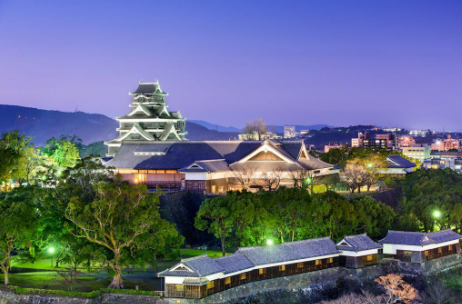
Source: travel.gaijinpot.com
4. Matsumoto Castle (Matsumoto-jō) – The Distinctive “Crow Castle” (*Karasu-jō*) 🖤
Matsumoto Castle, nicknamed “Karasu-jō” (Crow Castle) 🐦⬛, is one of the castles in Japan with the oldest existing *tenshu* (main keep) and is located in Matsumoto City, Nagano Prefecture. Constructed between the late 16th and early 17th centuries, this castle is characterized by its black, plank-covered walls and possesses a unique architectural style that combines elements of a flatland castle (Hirajiro) and a mountain castle (Yamajiro) ⛰️. Inside the castle, visitors can observe the various floors, steep stairs, and *yazama* (arrow loops) 🏹, providing a realistic glimpse into military life during that era.
📜 History
Originally, Matsumoto Castle was constructed around 1593–1594 by Ishikawa Kazumasa and Ishikawa Yasunaga.Miraculously, the castle escaped destruction during the Meiji Restoration (late 19th century) 🙏, preserving its historical beauty for the present day.
🚂🚌 Transportations
From Tokyo: Take the Limited Express Azusa from JR Shinjuku Station to Matsumoto Station (approx. 2 hours 40 minutes).
From Nagoya: Take the Limited Express Shinano from JR Nagoya Station to Matsumoto Station (approx. 2 hours).
From Matsumoto Station: The castle is just a 15–20 minute walk 🚶♀️. Alternatively, you can take the Town Sneaker bus to the “Matsumoto-jō mae” stop.
✨ Tourist Attractions Besides Matsumoto Castle
Nakamachi-dōri: A street lined with traditional storehouses characterized by black and white walls. It’s a perfect place to stroll, shop for crafts 🛍️, and enjoy local cuisine 🍜.
Matsumoto City Museum of Art : Features contemporary art, especially the polka-dot works of the renowned artist Yayoi Kusama 🎨.
Nawate temple: A street with a traditional atmosphere, featuring stores selling antiques and snacks, and where the frog is a symbol🐸.
Asama Onsen: The perfect place to relax after a day of exploring. It has many traditional *ryokan* (inns) that offer public and private hot spring baths ♨️.
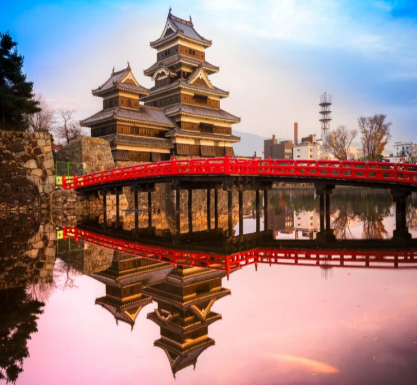
Source: saigontimestravel.com
5. Nagoya Castle (Nagoya-jo) – Symbol of Nagoya 🌟
Nagoya Castle, located in the heart of Nagoya City, Aichi Prefecture, is one of Japan’s most important castles. Built during the era of Shogun Tokugawa Ieyasu, the castle is famous for its two golden killer whales (Kinshachi) on the roof of the main keep 💰, symbolizing power and prosperity. Although the current main keep was reconstructed after the war, Nagoya Castle remains a captivating destination with its spacious grounds, traditional Japanese gardens, and the exquisitely restored Honmaru Goten Palace ⛩️.
Historical Background 📜
Nagoya Castle was built in 1612 under the order of Shogun Tokugawa Ieyasu. The castle played a strategically vital role and was once the capital of the Owari domain. Most of the castle was destroyed during World War II in 1945, but the main keep was rebuilt in 1959. Notably, the Honmaru Goten Palace was meticulously restored and fully opened to the public in 2018, allowing visitors to admire the architectural beauty of the Edo period.
Transportations🚂🚌
Subway: Meijo Subway Line to “Shiyakusho” Station (East Gate) 🚶♀️. Tsurumai Subway Line to “Sengen-cho” Station (West Gate). Bus: Me~guru Nagoya Sightseeing Route Bus from Nagoya Station to “Nagoya Castle.” From Nagoya Station: Take the Higashiyama Line to Sakae Station, then transfer to the Meijo Line to Shiyakusho Station.
Must-Visit Attractions and Cuisine in Nagoya ✨
Nagoya City Science Museum: Features the world’s largest planetarium 🔭 and many interactive exhibits.
Nagoya TV Tower: Enjoy panoramic views of the city from above 🌃.
Osu Kannon Temple and Osu Shopping Street: A historic temple and bustling shopping district with a wide variety of goods 🛍️.
SCMAGLEV and Railway Park: For train enthusiasts, showcasing generations of Shinkansen and Maglev trains 🚄.
Nagoya Port Aquarium: One of Japan’s largest aquariums with many marine species, including dolphins 🐬.
Nagoya’s Specialty Cuisine (Nagoya Meshi): Don’t miss Miso Katsu (pork cutlet with miso sauce) 🐷, Hitsumabushi (grilled eel rice served three ways) 🥢, Tebasaki (fried chicken wings) 🍗, and Kishimen (flat noodles) 🍜.
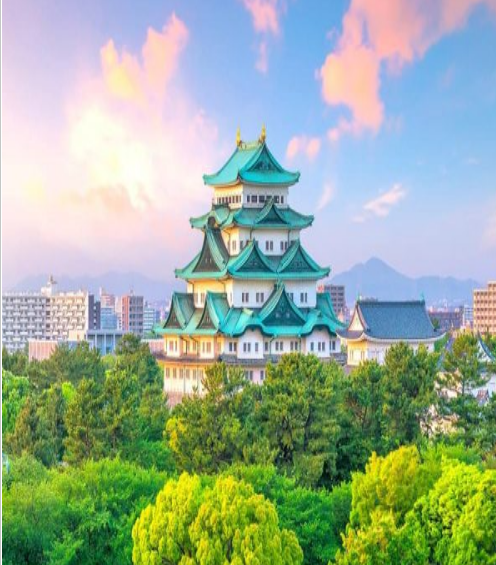
Source: nippontravel.vn
🧭 Conclusion ✨
Japan’s famous castles are not just beautiful structures; they are also living witnesses to the history and culture of the Land of the Rising Sun (*Hi izuru kuni*) 🇯🇵. Each castle has its own unique story and soul, waiting for visitors to discover and feel. Visiting these castles is a wonderful way to gain a deep understanding of Japan’s magnificent past and appreciate the sophistication of its traditional architectural art.
👉 Are there any other places you’d like to know about? Let Helpall know!



